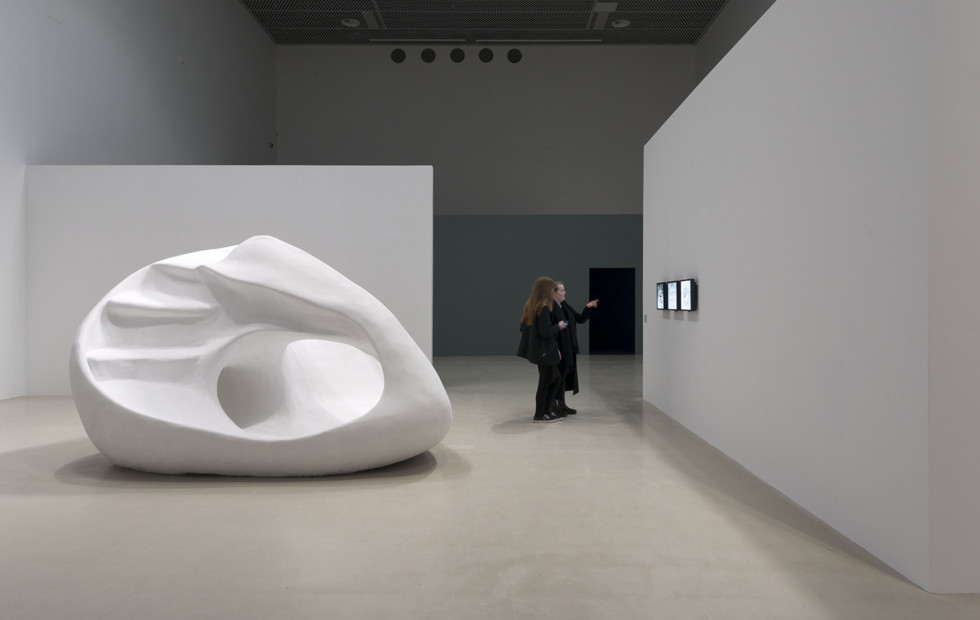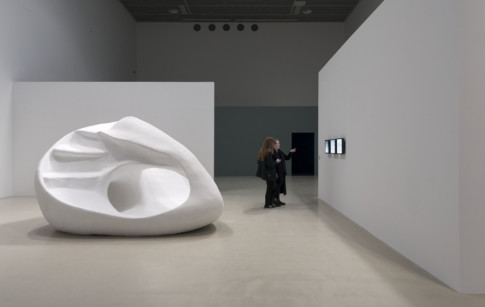
Installation view Annika Eriksson: The Social, Moderna Museet Malmö 11 March-4 june, 2017
In-depth
THE SOCIAL
“The term social refers to a characteristic of living organisms as applied to populations of humans and other animals. It always refers to the interaction of organisms with other organisms and to their collective co-existence, irrespective of whether they are aware of it or not, and irrespective of whether the interaction is voluntary or involuntary”.
wikipedia.org/wiki/social (october 2016)
The Social is the title of Annika Eriksson’s first comprehensive solo exhibition in her native town of Malmö. It focuses on the last few years of her artistic practice and is structured around a new series of works. Near the center of the exhibition stands a replica of Axel Nordell’s play sculpture “The Apple” 1 that since it was conceived in 1972, has been permanently placed in one of Malmö’s biggest parks, Pildammsparken. Among the new works are also objects made in papier-maché, a number of LEDsigns, and a blown-up photograph of an anarchistically oriented children’s workshop from the 1970s. While together forming an installation, these new pieces also create an environment—imbued with memories and associations— for the other works on display.
Throughout the exhibition, there is a predominant sensation of a gliding movement in time—between a past that is somehow still present and a future that already lurks in our consciousness. Also recurrent is a feeling of something elusive and constantly shifting, and as viewers we are often transported to indeterminate places, bordering with both reality and fiction. In one of Annika Eriksson’s most recent videos, Past Lives Selector (2016), we encounter two cosplayers that have been commissioned by the artist to create personas in relation to an open air history museum. Though they are both dressed in historical costumes, they appear oddly futuristic – like two medieval cyborgs.
A number of the exhibited works place themselves in the gaps that are created when social models fade into history before new ideas and visions have taken form. One example is the video In Preparation for a Psychodrama (2015), set in the Swedish town of Grängesberg. Here we encounter a group of people who, frustrated and searching, seem to have gotten stuck in a time pocket. While moving through an environment formed by ideals and visions of the past, they make repeated attempts to communicate with each other — perhaps even trying to create something new together — but fail to burst the bubble confining their existence.
Annika Eriksson’s long-running investigation into different forms of social interaction and organization also includes that between humans and other animals. In the video I am the dog that was always here (loop) (2013) we meet a pack of stray dogs that the authorities have removed from their familiar neighborhood and relocated to the outskirts of the growing city. Yet another video, The Community (2010), portrays a group of cats that used to be pets but that now live together in a park. While addressing the gentrification and sanitation of our cities, these works also focus on the emergence of informal social sites, that have in turn generated new modes of existence.The animals portrayed here are very much present in their own right, but also function as anthropomorphic protagonists in narratives on social change.
The Social is an exhibition that confronts us with physical and psychological effects of social transformation. The displayed works move with elusive rapidity between memories and visions of the future. Together, they create a melting pot of different time zones, mixing utopian promises from the past with dystopian fantasies, and glimpses of potential new futures.
Joa Ljungberg, curator
Whilst popularly referred to as The Apple, Axell Nordell’s sculpture in Pildammsparken, Malmö, is formally titled Le Fruit Rouge.

